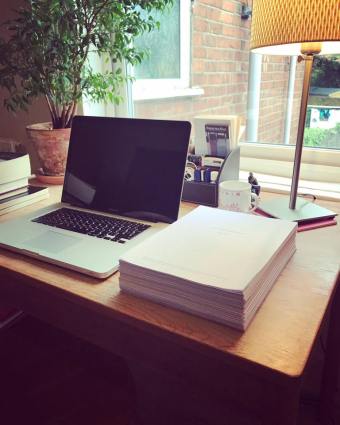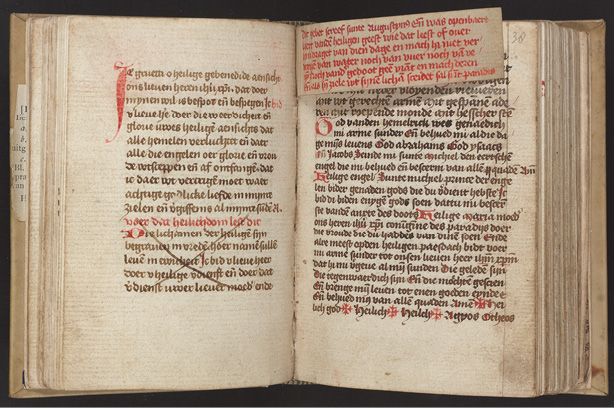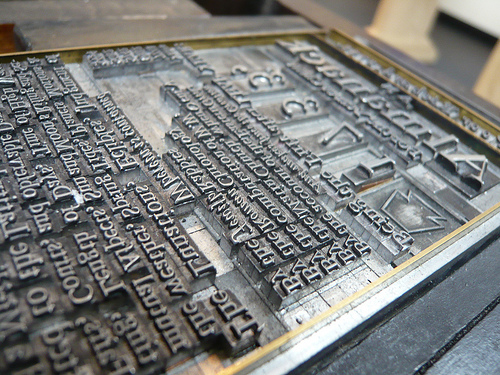When is a book a book? It’s a question I’ve asked myself many times in the last few months. For those of you who have been following my blog series, ‘A Writer’s Journey’, will remember that my manuscript, ‘Edward II the Man: A Doomed Inheritance’ was submitted to my publisher Amberley at the end of May this year. It was a significant moment, when all the years of research, all the visits to archives, libraries and private collections, as well as many hours of hard toil sat at my writing desk, finally came together.

So what has happened since? Well for the first two months, during June and July neither myself nor Amberley did much with the manuscript at all. I decided to take a long hard rest, rediscover my garden (and the odd glimpse of the British summer) and took the time to explore my new neighbourhood, having moved to Kings Heath in March this year. Between good coffees, reading novels, having dinner with friends, trips to London and mooching around antique shops, I had enough down time to really relax and remember what life was like before the last two years of hard graft writing. Despite the freedom and the good wine and even better company, I do miss my daily writing schedule and so, already having got the writer’s bug, I’m starting to think hard about my next project, which if I settle on one by the end of summer, I may embark on for the start of autumn. I love winter writing whilst wrapped up warm in woolly jumpers and with big mugs of tea.
Of course, there is another benefit of taking time away from your manuscript and is my first tip today. After submission there was the temptation to keep picking up my work and reading it in the hope that I might spot the odd typo or statement that required a tweak or some form of correction. I was a bit restless going from crazy long hours to nothing. However, despite the devil sat on my shoulder, I’ve resisted the urge to meddle. The benefit here is enormous. For by not looking at the manuscript at all has given me distance from it, which will be especially important when it comes back to me for the final reading before it goes to the printers. It will mean it will look almost new. The word blindness will have gone and I can read it more like a first time reader, than as the creator. I can be more critical and this – hopefully – can only be a good thing. So take my advice, take the summer off!

As July turned into August, Amberley began their work in earnest. My work was handed over by my senior editor, Shaun to the general editor, Cathy, who, armed with a red pen and a lot of patience, has read it from cover to cover – twice! Cathy is officially the first person to read my ‘book’. It’s an odd and exciting feeling at all the same time knowing that she has. She’s very good at her work. Her eyes are like a hawk’s and the typos fly off the page allowing her to put right my wrongs. When you write for publication, because the work is your own, you the writer own the words. You hold the copyright to them. Therefore when typos are discovered, sentences jar or the context does not make sense, it has been Cathy’s job to email me and suggest changes. The publisher cannot change it without your approval but from where I am sat, their specialist advice is hard to ignore. We work collaboratively on changes and together have added even more value to the manuscript…thankfully there were only minor tweaks anyhow. My arguments, the facts and the work remain true and unchanged. I have really enjoyed working with Cathy; a real pro.
If there is another tip to give here to any first time writer out there, it is this; no matter how wedded you are to your words, work with the editors, comprise and develop the content together where you need to, for collectively it makes for a rounder more appealing book. Four or six eyes are better than two. Tip number three; ask for feedback. As a first time writer in this field I asked my editors to tell me what they really thought. What worked well, how did the chapters read? Do they hang well together? What are the clangers? Did they get bored? Did anything drag? Did I overuse statements or words? I asked them to be brutal because only in feedback such as this can it help you develop a more rounded or pointed style.

We are also now working up the maps and genealogical tables that will appear at the start of the book. I was always clear from the start that I wanted to include these, believing it important for any audience to know who is who on a family tree is especially useful when looking back into history, which in Edward’s case, is some 700 hundred years ago. Equally, Edward travelled around England, battled in Scotland and headed into Europe. Having some of the key places noted in the book listed on a few maps with good keys I think helps to visually demonstrate his life story as much as the written chapters of the book. The map maker and designer have each done their work. Now this means I am currently spending hours carefully checking family trees, that people appear in the right order and are related to each other in the correct degree, and the names of towns, battle sites, abbeys and rivers are all spelt correctly and appear in the right place…it’s hard work but thankfully I love genealogy so I’m in my element!
We are also just about to start on the 39 glossy images for the middle of the book that I have selected from archives around Europe. The images are purchased, the captions written as long ago as May, but now we are working out how they will appear on the glossy pages so they to can tell the story of Edward’s life to. I don’t know about you but when I’m stood at a bookshelf in Waterstones or Foyles deciding to purchase a book or not, I always have a flick through the images. Who was it who said ‘a picture paints a thousand words’? Tip number four: pay attention to every detail of your book. The words are just one part of a much bigger picture.
Then there is the book cover. I wrote on my blog many months ago that the cover was sorted. It was, until we all changed our minds! Since then there have been four different versions produced – all on the internet – and all have not quite achieved what we want. This is ongoing, with my senior editor Shaun, myself and the designer working collaboratively to hit our brief. Personally I am finding this bit harder than the discipline of sitting down and writing the book altogether. Time is running out, and so within the next six weeks the final cover has to be sorted. Cross your fingers or toes for me. I hope whatever we settle on is beautiful.
Then there are the peer reviews. The daunting and also exhilarating moment when I get to talk to other historians and writers, asking them to provide a review of the manuscript which hopefully will appear on the back of the book. I know who I would like to give a review, so we are just about to start making the approach…let’s hope they say yes and also that they like what they read!

So the clock is ticking. Less than three months until the book’s release. The manuscript, still not officially a book, is now on it’s third reading, this time with my senior editor Shaun. At the end of the week, the manuscript will be sent to the typesetters who take all the content (the words, the images, the page numbers and chapter headings etc) and lay it out as a book, as currently it sits as A4 pages on Word. It will be the first time the future book will look like a book on screen and that for me is incredibly exciting. Once it has been type set it then comes back to me for the final reading. I have two weeks to read it throughly and make any final amends. After that, it goes back to Amberley and then as I understand it, is signed off and sent to the printers. Then and only then is a book a book. The first time I will see it will be a week or so before the release on 15 November 2017 when I receive a large box in the post with all my copies in it. Just writing this makes me have butterflies in my stomach.
I had never appreciated just how much work goes into each and every book. The research, the writing, the reading, the editing, the typesetting, the reviews, the design, the printing, not to mention the publicity. I have learnt an enormous amount as I have gone along this process having previously little or no knowledge of what to expect on this adventure. I hope sharing some of that here in this series has helped you become aware of what you to could be part of. It’s exciting, nerve-racking, hard work, great fun, stomach churning, soothing rollercoaster of emotions that all run alongside one another. It’s a heady adventure.
I would recommend it to anyone.
If you think writing is for you, go for it! You may just surprise yourself.
Edward II the Man: A Doomed Inheritance is available for pre-order at Amazon Waterstones Foyles Amberley
Twitter: @SpinksStephen
Facebook: Fourteenthcenturyfiend
You are so very right about the benefit of getting a bit of distance from your work – it’s invaluable! Even if it feels like you are abandoning a lover or child at first. I’m glad you got some rest and had some fun. The editing process can be a difficult experience but it seems you are handling it with aplomb. You have my admiration and I wish all the very, very best with your book!
LikeLiked by 1 person
Thanks Lucy. It’s been a real blast so far. Narrowing down the next project is the next big challenge.
LikeLiked by 1 person
Take your time, mull it over. but I know what you mean about missing your writing schedule. And you are exactly right about winter writing – bliss!
LikeLiked by 1 person
Wow this was a very exciting post to read! I enjoyed learning what the whole experience of writing a book was like for you, and also what your goals are moving forward with the next book. Definitely a lot of insight here for new writers hoping to one day finish editing their work and getting it seen by a professional editor with a publishing house. It seems like a long and arduous process, but it definitely seems worth it in the end. Looking forward to knowing how your process goes for the next book, keep up the great work with your articles and posts :)! Glad I stumbled onto your blog; undoubtedly so, I’ll be following :)!
LikeLiked by 1 person
Thank you. Really pleased you found the article interesting and thanks for the encouragement.
LikeLiked by 1 person
No problem, aesthetically speaking, the way you structured this post is incredibly eye-catching.
LikeLike
Covers are hard, aren’t they, even when you’re working with someone who’s really good at them. I can never explain terribly well what I’m looking for, but Cathy, the designer, is very patient. I’m looking forward to seeing the final version of your cover.
LikeLiked by 1 person
Well i have no such experience of the feeling of writing a book but i am sure it feels pretty same as explained by you. Indeed writing has some power and it gives immense pleasure. I have felt the roller coasters and the churning as well. 🙂 Best wishes for your upcoming.
LikeLiked by 1 person